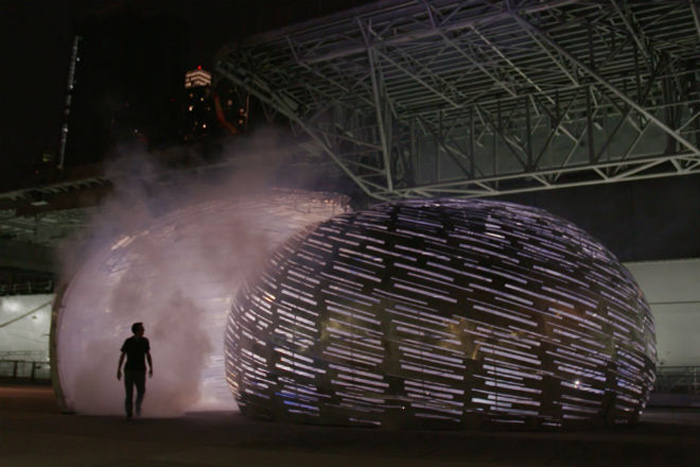Sculpture Puts You In Orbit With Satellites

An entire fleet of satellites is out there right now circling our planet, but we earthlings don't tend to notice.
Now a light-filled interactive sculpture is making those NASA satellites feel real by assigning them unique sounds. Want to hear the rush of a satellite zipping by? Step right in.
Exquisite Exoplanetary Art: Photos
NASA commissioned the Orbit Pavilion sculpture to transform the trajectories of their usually invisible satellite fleet into a tangible experience for the public. Normally their 19 satellites pass by unseen as they gather crucial scientific data about our planet including weather patterns, ocean currents, and air quality.
The architects at StudioKCA in Brooklyn agreed to take on the challenge. "The satellites are collecting data streams," principal Jason Klimoski told Co.Design. "That doesn’t really lend itself to good representation, so we had to think of a new creative way to do it."
Inspired by listening to a shell to hear the ocean, they decided to produce a similar effect for space. Shaped like a shell, the large sculpture contains 3,500 square feet of curved aluminum panels fitted together and bolted to an aluminum tube frame, representing orbital paths.
An EPIC View of the Moon in Earth’s Orbital Embrace
Get the Space.com Newsletter
Breaking space news, the latest updates on rocket launches, skywatching events and more!
Each satellite was given a unique nature-inspired sound by composer and acoustics consultant Shane Myrbeck. The Orbit Pavilion uses real NASA tracking data. That means visitors who stand inside the sculpture's 3-D sound chamber get to "listen to the sounds of NASA's satellites as they fly over, under and around them, in real time," according to StudioKCA’s project overview.
Here’s what it's like:
NASA Orbit Pavilion_HD Version from STUDIOKCA on Vimeo.
After the nautilus-shaped sculpture debuted last year at the World Science Festival in New York City, the pavilion moved to NASA's Jet Propulsion Laboratory in Pasadena. It will stay there for a few more months before moving to the Huntington Botanical Gardens, a 120-acre space in San Marino, Calif.
The hope is that, by the time visitors step outside the Orbit Pavilion again, they've gotten to know the satellites better — sort of like social networking on a different level. And we should recognize them. After all, they're always keeping an eye out for us.
Originally published on Discovery News.
Join our Space Forums to keep talking space on the latest missions, night sky and more! And if you have a news tip, correction or comment, let us know at: community@space.com.









